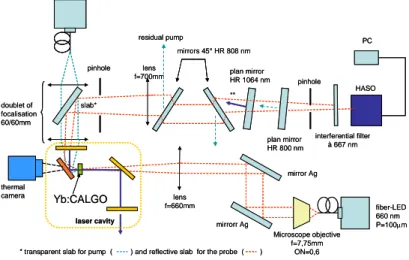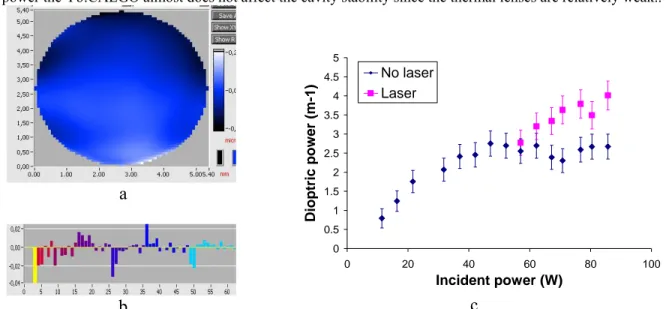HAL Id: hal-00808711
https://hal.archives-ouvertes.fr/hal-00808711
Submitted on 6 Apr 2013
HAL is a multi-disciplinary open access
archive for the deposit and dissemination of sci-entific research documents, whether they are pub-lished or not. The documents may come from teaching and research institutions in France or abroad, or from public or private research centers.
L’archive ouverte pluridisciplinaire HAL, est destinée au dépôt et à la diffusion de documents scientifiques de niveau recherche, publiés ou non, émanant des établissements d’enseignement et de recherche français ou étrangers, des laboratoires publics ou privés.
High power diode pumped Yb3+:CaGdAlO4 laser
Justine Boudeile, Julien Didierjean, François Balembois, Frédéric Druon,
Patrick Georges, Johan Petit, Philippe Goldner, Bruno Viana
To cite this version:
Justine Boudeile, Julien Didierjean, François Balembois, Frédéric Druon, Patrick Georges, et al.. High power diode pumped Yb3+:CaGdAlO4 laser. Advanced Solid-State Photonics, Jan 2008, Nara, Japan. �hal-00808711�
High power diode pumped Yb
3+
:CaGdAlO
4
laser
J. Boudeile, J. Didierjean, F. Balembois, F. Druon and P. GeorgesLaboratoire Charles Fabry de l’Institut d’Optique, Campus Polytechnique RD 128 91127 Palaiseau cedex
justine.boudeile@institutoptique.fr
J. Petit, P. Goldner and B. Viana
Laboratoire de Chimie Appliquée Etat Solide de l’Ecole Nationale Supérieure de Chimie de Paris 11 Rue P .et M. Curie 75231 Paris
Abstract: We study the performance of Yb3+:CaGdAlO4 under 100 W diode pumping with a standard laser design. We also investigate the laser properties of Yb3+:CaGdAlO
4 for different doping in order to optimize the absorption and wavelength tunability.
©2007 Optical Society of America
OCIS codes: 140.5680 Rare earth, solid state laser, 140.3480 Laser, diode-pumped,140.4050 Mode-locked lasers
1- Introduction Yb3+:CaGdAlO
4 [1] has been recently demonstrated to be very interesting for the development of next generation diode–pumped short-pulsed modelocked lasers. In fact, this crystal demonstrated two very promising properties. First, it has, to our best knowledge, the broadest and the flattest emission band of the Yb:doped materials. This allowed the generation of 47 fs pulses at a low average power of 38 mW [2]. Second, a recently presented model [3] allowed us to evaluate the thermal conductivity of undoped CaGdAlO4 at 11.4 W K−1m−1 and we measured the 2 at. % Yb:CALGO thermal conductivity to be 6.9 and 6.3 W K−1 m−1 along the a and c axis, respectively. This high thermal conductivity allows high-power pumping. Based on this result, we demonstrated the generation of 68 fs pulses with an average power of 520 mW for 15 W of pumping power[4]. Nevertheless, these works raised new interrogations on this crystal. First, is the ultimate pumping power for this crystal in the tens of Watts range? What is the thermal lens in this crystal? And more generally, what are the thermo-optical properties of this crystal? Second, because we observed that the absorption of the 2%-doped crystal is not optimal to maximize laser efficiency, more heavily doped crystals were grown. But, would the very exceptional spectral properties of Yb:CALGO be the same for highly-doped crystals? We try to answer these questions in this report.
2- Thermal behaviour of Yb3+: CaGdAlO4 under 100 W pumping
In order to access simultaneously to the temperature distribution (thermal camera 8-12 µm) and the thermal lens of the Yb:CALGO under lasing and not lasing conditions with an in situ longitudinal high power diode pumping, we developed the specific setup described on figure 1.
laser diode 120W 980 nm 400μm fiber-LED 660 nm P=100μm lens f=700mm lens f=660mm doublet of focalisation 60/60mm slab* HASO PC Microscope objective f=7,75mm ON=0,6 * transparent slab for pump ( ) and reflective slab for the probe ( )
** output laser mirror Ag mirrorr Ag laser cavity mirrors 45° HR 808 nm residual pump pinhole pinhole interferential filter à 667 nm thermal camera plan mirror HR 1064 nm plan mirror HR 800 nm ** Yb:CALGO laser diode 120W 980 nm 400μm fiber-LED 660 nm P=100μm lens f=700mm lens f=660mm doublet of focalisation 60/60mm slab* HASO PC Microscope objective f=7,75mm ON=0,6 * transparent slab for pump ( ) and reflective slab for the probe ( )
** output laser mirror Ag mirrorr Ag laser cavity mirrors 45° HR 808 nm residual pump pinhole pinhole interferential filter à 667 nm thermal camera plan mirror HR 1064 nm plan mirror HR 800 nm ** Yb:CALGO
The diode emits up to 120 W at 980 nm on a 400-µm diameter fiber-coupled output. The incident power on the 2%-doped Yb:CALGO is 86 W which corresponds to an absorption of 30 W without laser and 42 W with laser operation. Under these conditions the thermal lenses measured are f=37 cm without laser and f=25 cm with laser. As shown in fig. 2, the wavefront (wf) is almost no distorted. These results are very interesting because it shows that even at very high power the Yb:CALGO almost does not affect the cavity stability since the thermal lenses are relatively weak..
a
b
0 0.5 1 1.5 2 2.5 3 3.5 4 4.5 5 0 20 40 60 80 10 Incident power (W) Dio ptric pow e r (m-1 ) 0 No laser Laserc
Fig 2. thermal lens measurement: a) distorted wavefront (Pi=83 W), b) decomposition of this wf on the Zernike polynoms, c) thermal lens vs power.
A temperature mapping of the surface of the crystal has also been done using this system. The results are plotted in fig. 3. First, the crystal was set in a copper mount with contacts on 3 sides (bottom, left and right). Fig. 3a clearly indicates the lack of thermal dissipation on the fourth face. In these conditions we observed a global temperature elevation of 105 °C for 83 W of incident pump power and a temperature gradient in the crystal of 20 °C. This relatively small increase of temperature clearly confirms the excellent conductivity of this crystal and contributes to the small thermal lens. a 80 85 90 95 100 105 110 0 2000 4000 6000 8000 10000
Position in the crystal (um)
Te mpe ra tur e ( °C ) Pump beam b 0 5 10 15 20 25 0 20 40 60 80 100
Incident pump power(W)
Del ta T ( °C) No laser Laser
c
Fig 3. Thermography: a) temperature image (Pi=83 W), b) extracted profile, c) temperature gradient vs power.
3- Laser operation of Yb3+
:CaGdAlO4 under 100 W pumping
A simple V-cavity has been developed with this crystal in order to test it's laser performances. The setup is described in figure 4. laser diode 120W @ 980 nm 400 μm output Coupler 5% mirror RoC= 300 mm crystal
plan dichroïc mirror laser diode 120W @ 980 nm 400 μm output Coupler 5% mirror RoC= 300 mm crystal
plan dichroïc mirror
The laser power versus incident pump power is plotted in figure 5. We obtained up to 15 W output power in this configuration. The measurement of the absorbed pump power clearly indicates that only half of the incident power is absorbed in the 2%-doped Yb:CALGO under laser condition and only one third with no lasing (due to the saturation of absorption in this condition). This absorption measurement indicates that the 2-% doping is probably too low.
0 5 10 15 20 25 30 35 40 45 0 20 40 60 80 100
Incident pump power (W)
A b s o rbed pu mp power ( W ) 0 5 10 15 20 25 30 35 40 45 La ser power ( W ) Pabs laser Pabs no laser P laser
Fig 5. Laser power and absorbed powers vs incident pump power.
4- Higher doped crystals
We decided to investigate different doped crystals in order to optimize the absorption. Our main concern was then the emission band. In fact, since the very particular emission band flatness of Yb:CALGO is provided by two exactly compensated crystallographic sites, this exact compensation is a priori not obvious for all doping ranges. We made some experiments to compare the emission spectra using a (low power) tunable laser with 2, 3.5, and 5-% doped crystals (fig. 6). Since no obvious differences appear in the tunability spectra for higher doping, one could expect to have similar performance in femtosecond regime than with the 2% doped crystal.
0 100 200 300 400 500 600 700 800 1000 1020 1040 1060 1080 1100 Wavelength (nm) P o w er (m W ) CALGO:Yb(3,5%) 1,5mm CALGO:Yb(5%) 0,7mm CALGO:Yb(2%) 3mm AR
Fig 6.laser tunability for different crystal doping concentrations.
5- Conclusion
In conclusion, we have demonstrated laser operation of Yb:CALGO pumped with 100W of pump power. We obtained 15 W of laser operation for 42 W absorbed power. We also investigated both temperature elevation and thermal lens in these conditions. Both results corroborate the excellent thermal behavior of Yb:CALGO. The 2-% Yb:CALGO demonstrates the exceptional quality of combining good thermal properties with a large emission and ultra-flat bandwidth. In order to optimize the absorbed power in a future work, we also investigated in a preliminary phase the spectral tunability for different higher doping concentrations.
6- References
[1] J. Petit, P. Goldner, and B. Viana, "Laser emission with low quantum defect in Yb:CaGdAlO4," Opt. Lett. 30, 1345-1347 (2005)
[2] Y. Zaouter, J. Didierjean, F. Balembois, G. L. Leclin, F. Druon, P. Georges, J. Petit, P. Goldner, and B. Viana, "47-fs diode-pumped Yb3+:CaGdAlO
4 laser," Opt. Lett. 31, 119-121 (2006)
[3]R. Gaumé, B. Viana, D. Vivien, J. P. Roger, and D. Fournie, “A simple model for the prediction of thermal conductivity in pure and doped insulating crystals”Appl. Phys. Lett. 83, 1355 (2003).
[4] J. Boudeile, F. Druon, M. Hanna, P. Georges, Y. Zaouter, E. Cormier, J. Petit, P. Goldner, and B. Viana, "Continuous-wave and femtosecond laser operation of Yb:CaGdAlO4 under high-power diode pumping," Opt. Lett. 32, 1962-1964 (2007)


